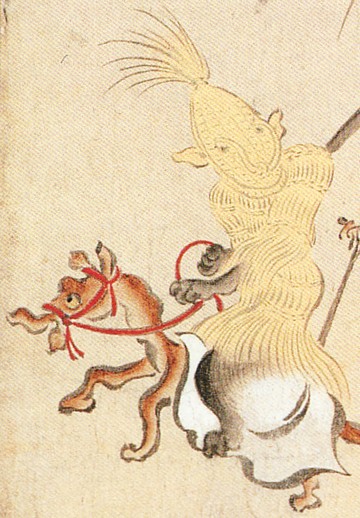
Every new year’s eve, on the Oga Peninsula (男鹿半島) or Akita Prefecture (秋田県), a yokai pair returns from the nether lands. They search for the bad and the lazy, especially children. Just like Santa Claus, or dark Krampus, the local red and blue yokai couple reminds the children to be well-behaved for the coming year.
In recent months, 10 festivals of the Raiho-shin (来訪神) has been inscribed into the UNESCO Intangible Cultural Heritage, and the yokai, Namahage of Oga, is one of them. Namahage is a pair of red and blue oni-like yokai that visits households every new year’s eve. They are part of the Toshigami (年神) group because they are deities that return to the land of Japan with each new year.
Namahage are oni-like yokai with large teeth and horns who walk around the village looking for the delinquents, especially young ones. They are usually dressed in a traditional Japanese straw raincoat called mino (蓑). These deities will shout out loud, “Are there any naughty children?” or “Are there any children whining?” Many unsuspecting children will be caught and interrogated by the Namahage. Questions about their general behaviour over the year, and even whether they have been studying hard.
Namahage Types

The red Namahage is known as Jiji-namahage, or simply Jiji. He waves around an Onusa (大幣), a wooden wand with “lightning” paper streamers. This deity exorcises all forms of delinquencies, especially laziness and naughtiness. He ensures that the household is rid of bad habits that accumulates over the year. Purifying the house and family for the coming new year.

Baba-namahage is the other Namahage, the blue (and more threatening) one. In her right hand, she carries a kitchen deba knife (出刃包丁) and hunts for those who have idle excessively. She “helps” to cut the heat blisters which comes from lazing around the fire too much. Baba collects all these blisters in her teoke (手桶), a wooden hand bucket.
Many towns and villages have stopped the Raiho-shin (来訪神) practice and eventually these deities may become a footnote yokai like the tanuki. But until then, namahage make sure that everyone does their part for the community in the coming dead of winter. No lazing around. I’m looking at you kid!
Yokai Details
- name: namahage (nah-mah-hah-gay)
- kanji: ナマハゲ (なまはげ)
- meaning: raw peels (archaic form)
- abilities:
- phobia pheromones — release pheromones that induce fear among a large population
- exorcise delinquency — gets rid of laziness and discord
- oni transformation — able to change into a large semi-demonic ogre






